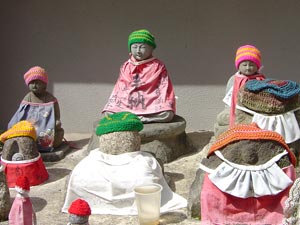light-bulb nutrients
April 24, 2004
There are are a number of myths about foreigners that a surprising number of people in Japan seem to believe to a greater or lesser extent. A lot of these are to do with how difficult it must be to live in Japan if you’re not Japanese. One problem is that the Japanese language is almost impossible for foreigners to ever grasp. We might learn enough to read roadsigns and menus, ask for directions, have conversations, and maybe even read Japanese literature, but we can never really grasp the language, because it’s so difficult. Another difficulty foreigners face is the challenge of having to eat with chopsticks instead of spoons, and consequently we face the real threat of malnourishment in the midst of plenty, just because everything we try to eat just slips off our chopsticks before it reaches our mouths.
This is a particularly odd myth, because it seems to be based on an idea that chopsticks are specifically Japanese, and misses the fact that just across the East China Sea, on mainland Asia, about a fifth of the world’s population – and all of them foreigners – are also getting by perfectly ok with chopsticks. The insular mindset that the whole “ooh, you’re eating with chopsticks” attitude implies annoys me, and I usually can’t help saying something along the lines of “yeah, well, there are loads of Chinese restaurants in Britain, see…”
Another difficulty for foreigners is that there are so few of us – Japan is one of the most culturally homogenous countries in the world – so we must be lonely. Although inquiries about loneliness are always well-meant, they still boil down to a benevolent sort of racism, because the implicit assumption seems to be that we couldn’t have Japanese friends.
The last two myths (plus God knows how many others that I’m not aware of, and which, together, might actually make some sense of what follows) came together in a surreal exchange in the supermarket queue the other day with the school librarian, who seems to particuarly enthusiastically buy into mad ideas about foreigners. She pointed at my shopping basket – which contained only a carton of fruit juice and a 60 Watt light bulb – and then at her full basket and looked at me and giggled, as if I should understand what the joke was. This set my teeth on edge, so I asked what was funny. She explained that “I have to buy all this because I have so many mouths to feed. But you live alone, so you don’t need much at all.”
As with lots of the things she says, my mind reeled trying to grasp the network of assumptions that you would have to hold in order to think that that made any kind of sense… She has a family, so she has to buy lots of food, whereas I, being alone and foreign, can subsist off nothing more than a carton of fruit juice and whatever nutrients I can lick off the glassy surface of a light-bulb? If so, how long does she think one light-bulb lasts me? That’s what I want to know.

